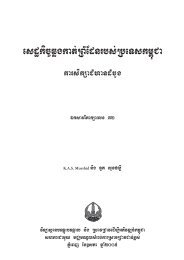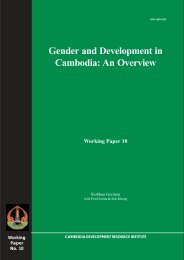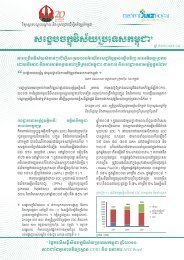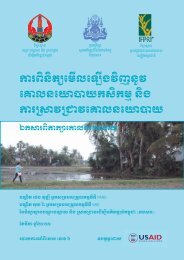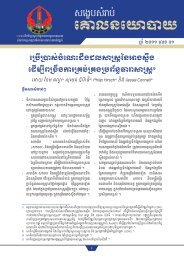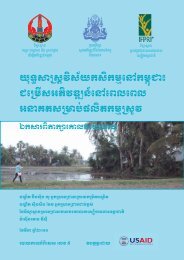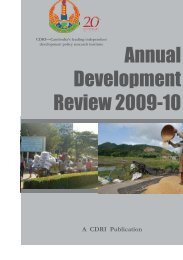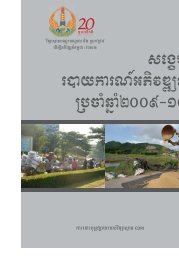62) decentralised governance of irrigation water in cambodia - CDRI
62) decentralised governance of irrigation water in cambodia - CDRI
62) decentralised governance of irrigation water in cambodia - CDRI
Create successful ePaper yourself
Turn your PDF publications into a flip-book with our unique Google optimized e-Paper software.
Yet over time, the development orthodoxy <strong>of</strong> match<strong>in</strong>g modern physical schemes with<br />
modern, expert-driven <strong>governance</strong> has been challenged by an <strong>in</strong>creas<strong>in</strong>g depth <strong>of</strong> empirical<br />
evidence. An early critique was provided by Coward (1976), based on his study <strong>of</strong> the newly<br />
modernised Nam Tan <strong>irrigation</strong> area <strong>in</strong> western Laos. Coward concludes that the area’s preexist<strong>in</strong>g<br />
<strong>water</strong> management traditions did not <strong>in</strong>hibit the modernisation process at all – <strong>in</strong> actual<br />
fact, the retention and adaptation <strong>of</strong> these traditions strongly contributed to the success <strong>of</strong> the<br />
new <strong>irrigation</strong> schemes. Rather than becom<strong>in</strong>g irrelevant, traditional leadership roles (such as<br />
the village “<strong>water</strong>man”) were be<strong>in</strong>g adapted to form a crucial “middle rung” <strong>of</strong> <strong>governance</strong>,<br />
which l<strong>in</strong>ked the efficiency <strong>of</strong> the regional <strong>water</strong> bureaucracy with the social networks and<br />
cultural cohesion <strong>of</strong> local <strong>water</strong> users.<br />
In theory at least, this hybrid structure <strong>of</strong> modern and traditional <strong>irrigation</strong> <strong>governance</strong><br />
bears a resemblance to Cambodia’s FWUC system. As set out by the M<strong>in</strong>istry <strong>of</strong> Water<br />
Resources and Meteorology (MOWRAM) and the national FWUC statute, FWUCs are<br />
<strong>in</strong>tended to function as <strong>in</strong>dependent community organisations, whose leaders are responsible<br />
for liais<strong>in</strong>g with higher authorities while rema<strong>in</strong><strong>in</strong>g primarily accountable to local <strong>water</strong> users.<br />
Yet <strong>in</strong> practice, FWUC leaders may lack the skills and <strong>in</strong>centives to do their jobs effectively.<br />
Furthermore, FWUC committees may struggle to navigate the pre-exist<strong>in</strong>g loyalties and power<br />
structures that exist both above and below their “middle rung” on the <strong>water</strong> <strong>governance</strong> ladder.<br />
The speculative phras<strong>in</strong>g here is deliberate: the current literature provides little evidence to<br />
confirm or dismiss these issues. This work<strong>in</strong>g paper aims to provide a more reliable empirical<br />
basis for discuss<strong>in</strong>g and resolv<strong>in</strong>g these potentially significant problems with<strong>in</strong> Cambodia’s<br />
<strong>irrigation</strong> <strong>governance</strong> regime.<br />
In contrast to Coward’s work <strong>in</strong> Laos, Lans<strong>in</strong>g’s (1987) study <strong>of</strong> traditional Bal<strong>in</strong>ese “<strong>water</strong><br />
temple” <strong>irrigation</strong> presents a more prist<strong>in</strong>e and idealised example <strong>of</strong> <strong>irrigation</strong> <strong>governance</strong>.<br />
Over several hundred years <strong>of</strong> organic development (prior to the Green Revolution <strong>of</strong> the<br />
1960s onwards), Bali’s culturally-embedded <strong>water</strong> <strong>governance</strong> <strong>in</strong>stitutions (subaks) became<br />
f<strong>in</strong>ely matched to the physical dimensions <strong>of</strong> its <strong>irrigation</strong> schemes. This relationship may<br />
even have been mutually re<strong>in</strong>forc<strong>in</strong>g; for example, religious festivals were used to publicly<br />
calibrate Bali’s complex dual calendar system so that farmers could accurately synchronise their<br />
<strong>irrigation</strong> <strong>water</strong> requirements (Lans<strong>in</strong>g 1987: 330-332). Work<strong>in</strong>g <strong>in</strong> the opposite direction, the<br />
physical flow <strong>of</strong> <strong>water</strong> represented an important foundation <strong>of</strong> Bal<strong>in</strong>ese culture and religion.<br />
Lans<strong>in</strong>g implies that the multi-dimensionality <strong>of</strong> these l<strong>in</strong>ks enabled effective coord<strong>in</strong>ation<br />
and conflict resolution without the need for the centralised “oriental despotism” suggested by<br />
Wittfogel (1957). Accord<strong>in</strong>g to Janssen (2007: 188), Lans<strong>in</strong>g and Kremer (1993) were able to<br />
show that “simple bottom-up <strong>in</strong>teractions <strong>of</strong> subaks can lead to good performance <strong>of</strong> a very<br />
complex large-scale <strong>irrigation</strong> system”.<br />
Superficially at least, Lans<strong>in</strong>g’s account <strong>of</strong> traditional Bal<strong>in</strong>ese <strong>irrigation</strong> seems far<br />
removed from the present situation <strong>in</strong> Cambodia. In comparison to Bali’s ancient agroecosystems<br />
and socio-cultural cont<strong>in</strong>uity, Cambodia’s <strong>irrigation</strong> <strong>governance</strong> <strong>in</strong>stitutions could<br />
be def<strong>in</strong>ed as very recent and very unstable. This argument holds some truth: Cambodia’s<br />
long history <strong>of</strong> political disruption and <strong>in</strong>ternal migration (especially dur<strong>in</strong>g the Khmer Rouge<br />
period) has completely prevented a synergy <strong>of</strong> its physical and socio-cultural topographies<br />
from develop<strong>in</strong>g, notwithstand<strong>in</strong>g the fact that the Bal<strong>in</strong>ese case is perhaps unique. Yet <strong>in</strong> other<br />
ways, this argument should be treated with great care. Despite periods <strong>of</strong> disorder, policymakers<br />
should not presume that Cambodia represents a “clean slate” <strong>in</strong> terms <strong>of</strong> <strong>irrigation</strong> structures<br />
and <strong>irrigation</strong> <strong>governance</strong>. On the contrary, aerial surveys and archaeological evidence suggest<br />
6 Decentralised Governance <strong>of</strong> Irrigation Water <strong>in</strong> Cambodia: Match<strong>in</strong>g Pr<strong>in</strong>ciples to Local Realities



